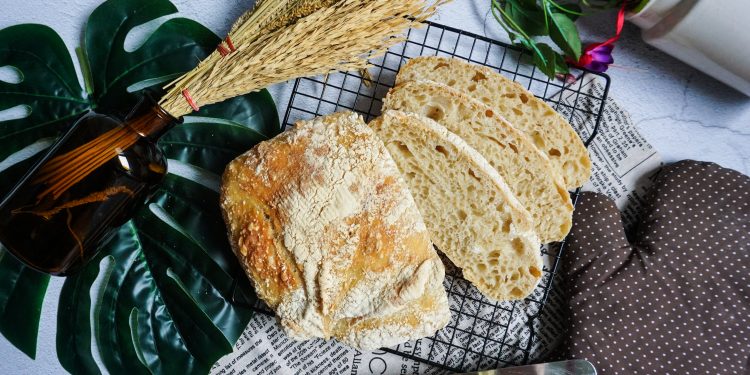I’m a self-professed baker. I do enjoy hobby baking, usually trying out new bakes that spark my interest. There is always a sense of satisfaction when I see my baked goods come to life, a finished product conjured out of basic, raw ingredients. But what is more fulfilling from the entire baking process is that special allure of being able to create something from scratch, putting in my blood sweat and tears (metaphorically) to produce something that I can proudly say I made on my own.
One thing that I’ve always wanted to try baking is bread, but the thought of having to use my strength and effort to knead the dough is off-putting.

Every time I lament to my friends about my laziness when it comes to baking, they would chide me for a bit, before offering recommendations on a good stand mixer that I could use to have the dough kneaded out for me. Well, that would work, but I wouldn’t feel that sense of accomplishment of actually making the bread — utilising help from a stand mixer would mean that my only job is to measure out the ingredients, pour everything in, and pop it in the oven.
Just only in the recent months during the circuit breaker did I stumble upon the (in)famous no-knead bread recipe by The Times. A quick search on Google revealed the recipe had a full, 5-star rating by nearly 12,000 readers who have put the recipe to the test.
This bread recipe was the answer to my oxymoronic nature. A no-knead bread recipe meant that I could do the entire preparation and execution by hand, without having to break a sweat. There was no need for a machine, neither was there a chance for me to feel that lack of accomplishment — I’m literally doing all the steps of the recipe, by my own two hands, to a tee.

I started preparing the ingredients the night before since the recipe stated that the dough had to rise for more than 12 hours. This recipe calls for only four very basic ingredients — flour, yeast, salt, and water — and everything can be prepared in one mixing bowl.
I first weighed out the flour, yeast, and salt in a large mixing bowl. I then added water, and mixed the mixture with a wooden spatula. You’ll know it’s ready when the mixture turns homogeneous and resembles a wet and sticky dough. I then use a plastic bench scraper to scrape the excess dough off the sides and on my wooden spatula, tossing them back into the large mixture. There is no room for waste here! I then covered the mixing bowl with some cling wrap and left it on the kitchen counter to ferment.
The next morning, I was greeted with a beautiful sight — a foamy mixture with a distinct sour aroma — only given off when yeast cells are active and happy. I was told that the longer the dough is allowed to ferment, the more texturised the bread will be. I resisted the temptation to immediately bake the bread and continued letting the mixture ferment for another three hours.
I then excitedly poured my still foamy dough mixture on a well-floured surface, used my bench scrapers to pull it over itself, and covered it back with the cling wrap again for another 15 minutes. My hands still have not touched the dough, and I’ve not even broken a single drop of perspiration at all.
Apart from having to knead dough, the other thing I don’t like about making bread is when I am required to come into contact with soft and sticky dough. There’s just something about that stickiness that I abhor. Nevertheless, I’ve come too far to give up at this point, and I reluctantly followed the instructions to (generously) coat my hands with flour before shaping the dough into a ball.

I then tossed the dough ball back into the mixing bowl, this time lined with a well-floured tea towel on the bottom. The dough had to rest for another two hours before baking. It really takes THAT long.
After what felt like eternity, I preheated my oven and baking dish, coated the base and lid with some oil and tossed the dough ball in, setting the temperature to 230°C for 30 minutes. Once that was done, I continued baking for another 15 minutes with the lid off till the bread was golden brown. At this point of baking, I already felt that sense of gratification. The whole kitchen was filled with the aroma of freshly baked bread (I bet my neighbours caught a whiff of it and were filled with jealousy).

Alas, I could take the bread out of the oven and allowed it to cool for another 15 minutes on a wire rack. I spent that 15 minutes observing its beautiful crust, ever so slightly using my finger to poke the bread to see if it was ready to be sliced, bread knife on the ready at the side. And there it was. A delicious slice of homemade, no knead bread. It had a crusty, almost crispy exterior, and a soft, fluffy interior filled with beautiful pock-marks — signs of a well-fermented dough. The bread was slightly on the sour side, but went perfectly with some butter spread and sprinkle of sea salt.
I now have a pretty picture to upload on my Instagram, a proud sense of accomplishment, and a huge loaf of bread for me (and my family) to consume within the next two days.

INGREDIENTS
- 430 g bread flour, plus more for dusting
- ¼ teaspoon instant yeast
- 2 teaspoons table salt
- 390 ml water
- 1 tbsp cooking oil, for coating baking pan
METHOD
- In a large mixing bowl combine flour, yeast and salt and mix well.
- Add in water and continue stirring, until dough is a homogeneous sticky mixture.
- Cover the bowl with cling wrap and let the dough rest for at least 12 to 18 hours at room temperature.
- After resting, the dough should be foamy and rose a little.
- Lightly flour a work surface and place dough on it; sprinkle it with a little more flour and fold it over on itself once or twice.
- Cover loosely with plastic wrap and let rest about 15 minutes.
- Using just enough flour to keep dough from sticking to work surface or to your fingers, gently and quickly shape dough into a ball.
- Generously coat a tea towel with flour, toss the dough ball in and dust with more flour.
- Cover with another cotton towel and let rise for about 2 hours. When it is ready, dough will be more than double in size and will not readily spring back when poked with a finger.
- Preheat oven to 230°C. Heat an 8 inch baking pan in oven while preheating. Remove baking pan from oven when heated, place dough inside, cover and bake for 30 minutes.
- Remove cover and bake for remaining 15 minutes, or until bread turns golden brown. Cool on a rack before slicing and serving.














